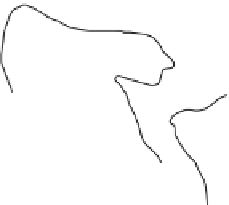Geology Reference
In-Depth Information
a description of the seismic units and sequences).
In these two sequences, core Clino penetrated
the relatively steep (~4°) part of the prograd-
ing clinoform (Eberli & Ginsburg, 1987). The
two main fracture intervals (upper and middle)
are within sequence
e
, and a third, thin frac-
ture interval (lower) is at the top of sequence
f
(Fig. 2). The SSB-D and a disconformity just above
it, represent an interval of non-deposition and/
or erosion with a duration of about 0.5-0.8 Myr.
Above SSB-D, a ~275-m-thick package of sedi-
ment associated with prograding sequence
d
was
deposited in a period of between 0.1 and 0.2 Myr.
The three fractured intervals are closely tied to the
lithological variation in the slope sediments. The
majority of fractures (upper and middle interval)
occur specifi cally within coarse, well-cemented
skeletal deposits. These skeletal deposits, termed
'interruptions' by Kenter
et al
. (2001), represent
margin-derived sediments deposited within (or
interrupting) the background platform-derived
sediment. The sediment 'interruption' beds are
interpreted by Kenter
et al
. (2001) as transported
to the slope during times when most of the plat-
form was subaerially exposed. The overlying and
underlying fi ner-grained hemipelagic or 'back-
ground' sediments that are shed to slope during
times of platform fl ooding and high sedimentation
rates are generally less indurated and contain less
fractures. Seismic sequence
e
represents sediments
deposited during a major backstep of the platform
margin (to the east) and a period of platform aggra-
dation (McNeill, 2005). The slightly coarser grain-
size probably promoted more rapid cementation
relative to the fi ner-grained and less permeable
hemipelagic sediments (Westphal & Munnecke,
1997; Kenter
et al
., 2001). This preferential early
cementation is also supported by rock magnetic
studies on the fractured and non-fractured inter-
val, where (very) early cementation appears to
have preserved chains of magnetite crystal from
magnetotactic bacteria (McNeill, 1997).
80
o
79
o
78
o
77
o
N
76
o
Little Bahama Bank
27
o
Florida
Great Abaco Island
26
o
Miami
Bimini
Eleuthera
25
o
New
Providence
CLINO
Andros
UNDA
Exuma
Sound
Great
24
o
Cay Sal
TOTO
Bahama
Bank
23
o
100 km
Cuba
Fig. 1.
Map showing the location of core Clino on the
western margin of Great Bahama Bank. The location of the
seismic line on which the line drawing (Fig. 2) is based is
also shown. TOTO stands for Tongue of the Ocean.
Straits of
Florida
Great Bahama Bank
Clino
Unda
8.5 km
SW
NE
Sea-level
a
&
b
a
SB
c
0.1
b
SB
c
d
e
SSB-D
SB
0.2
SB
SSB-E
d
SB
f
g
0.3
SB
h
S
B
SB
0.4
e
h
SB
i
0.5
f
SB
SB
k
0.6
i
l
S
B
k
0.7
SB
SB
m
l
0.8
SB
SB
Fig. 2.
Line drawing of the seismic sequences penetrated by core Clino (from Eberli
et al
., 2001). Clino fractures occur in
sequence
e
(bounded by red lines). Fractures in sequence
e
occur primarily in beds of coarse skeletal sediment redeposited
downslope from a shallow-water source area east of core Unda. The shaded areas indicate onlapping packages.



































































































































































































